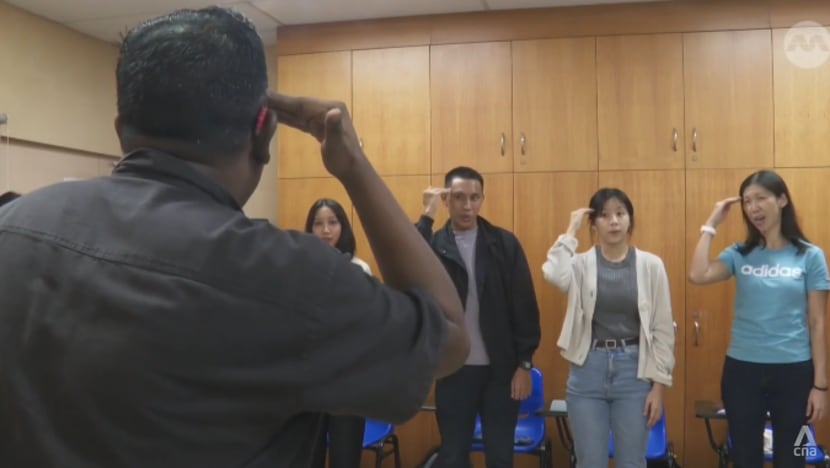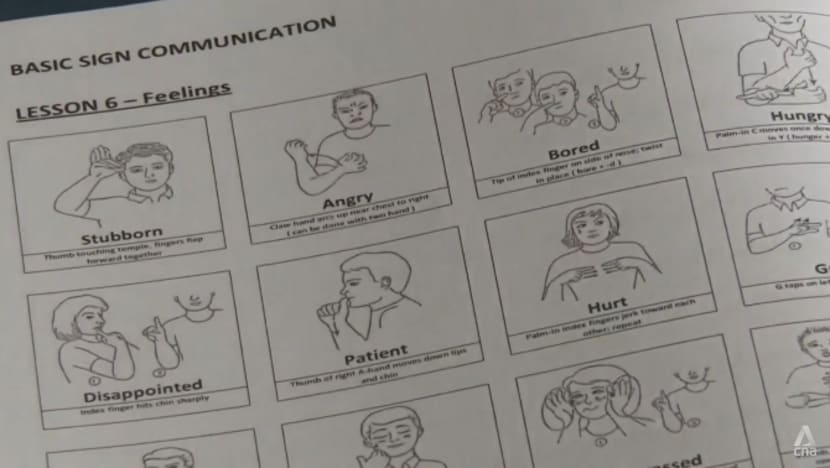Deaf community welcomes study on an official sign language in Singapore, but educational challenges remain
Challenges remain over differing grammar and language systems between the Singapore Sign Language (SgSL) and the English language.

Students learn the Singapore Sign Language.

This audio is generated by an AI tool.
SINGAPORE: A government study on whether to turn a local sign language into a national one is welcomed by the deaf community, but challenges remain over how it would be taught in school.
The Singapore Sign Language (SgSL) is a 70-year-old home-grown mix of Shanghainese and American sign languages that also uses manually-coded English and words from the local vernacular.
The Social and Family Development Ministry (MSF) is conducting a review on whether making SgSL the country’s official sign language can bring tangible benefits.
Many in the deaf community said having this uniquely Singaporean version as the national standard could be a game-changer.
“SgSL's recognition is very important because it gives us – the deaf community – a true sense of identity,” said Ms Lily Goh, a deaf arts and music practitioner and performer.
“With this recognition, accessibility is enhanced, and standards are increased. Better access will result in better education… such as improving comprehension levels. It could also maybe give us better employment opportunities.”
NO STANDARDISED SIGN LANGUAGE
While SgSL is commonly used in Singapore, there is no nationwide standardised sign language. The community also uses other signing systems.
Currently, some schools teach SgSL, some teach the formal signing system called Signing Exact English (SEE), and some teach both. The two can be quite distinct in some contexts.
The community hopes that by making SgSL the standard, its usage can cut across more aspects of life.

“With the official recognition of SgSL – in the sense that it's recognised as a real language, an officially accepted language by the government, by authorities, and by society at large – then it will be easier for us to push for more accessibility and accommodation,” said Mr Alvan Yap, deputy director of the Singapore Association for the Deaf (SADeaf).
He added these include advocating for sign language interpretation in the media, and in daily life settings such as in classrooms, at hospitals and workplaces.
CHALLENGES IN SCHOOLS REMAIN
However, some educators cautioned that SgSL cannot replace SEE, which mirrors English vocabulary and grammar.
Students with hearing loss need to know SEE for national examinations in English, such as the O-Level examinations, they said.
“SgSL expresses in a more visual, manual mode of language. To teach English to students you use the SEE tool – a signing system that visually represents every English word,” explained Ms Goh.
She added that both should be taught simultaneously.
SIGN LANGUAGES IN SCHOOLS
In response to CNA's queries about how SgSL might be rolled out, the Education Ministry's (MOE) message is that there is no one size that fits all.
For students who require signing support in schools, SgSL is the language for school programmes and daily communication.
To support students in accessing the national curriculum, the ministry has two mainstream schools – Mayflower Primary School and Beatty Secondary School – designated with resources and SgSL-trained staff.
Specialised teachers and interpreters also can tailor their teaching methods to suit students' needs, which include using SEE to teach English.
Students may also be provided with access arrangements for national examinations, such as exemption from the listening comprehension component, or the use of a sign language interpreter.

SENSE OF IDENTITY
Some educators said making the SgSL official can standardise communication and foster more inclusivity. It can also give the community a sense of pride and belonging.
“The deaf community is proud of our own unique language, which is local and originated in Singapore. This is a Singapore language. It comes from Singapore. It is made in Singapore,” said Mr Yap.
Ms Goh added: “Sign language and English are not the same. Each has its own grammar structure and semantic rules. Both are legitimate languages and should be treated as equal. Hearing and deaf people can work together to make society truly inclusive.”
The 44-year-old is also the manager of Hush TeaBar, a social movement led by deaf facilitators and people recovering from mental health conditions.
In addition, she runs SgSL classes in hopes of forging closer ties between the deaf community and the public.
“I hope to have more people become allies, and possibly for them to become interpreters in future. Because right now, there are very few interpreters,” she said.
According to SADeaf numbers, there are about 500,000 individuals with hearing loss in Singapore, with over 5,400 registered with the association.














